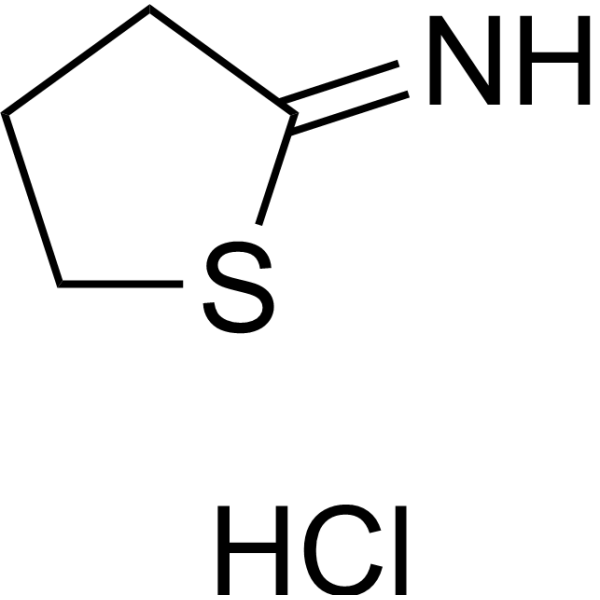
2-Iminothiolane HCl
CAS No. 4781-83-3
2-Iminothiolane HCl( 2-Iminothiolane | 2-IT | Trauts reagent | Traut's reagent )
Catalog No. M27200 CAS No. 4781-83-3
2-Iminothiolane HCl is a useful RNA-protein crosslinking reagent and an effective thiolation reagent for the introduction of sulphydryl groups into oligosaccharides.
Purity : >98% (HPLC)
 COA
COA
 Datasheet
Datasheet
 HNMR
HNMR
 HPLC
HPLC
 MSDS
MSDS
 Handing Instructions
Handing Instructions
| Size | Price / USD | Stock | Quantity |
| 10MG | 37 | In Stock |


|
| 50MG | 41 | In Stock |


|
| 100MG | 43 | In Stock |


|
| 200MG | Get Quote | In Stock |


|
| 500MG | Get Quote | In Stock |


|
| 1G | Get Quote | In Stock |


|
Biological Information
-
Product Name2-Iminothiolane HCl
-
NoteResearch use only, not for human use.
-
Brief Description2-Iminothiolane HCl is a useful RNA-protein crosslinking reagent and an effective thiolation reagent for the introduction of sulphydryl groups into oligosaccharides.
-
Description2-Iminothiolane HCl is a useful RNA-protein crosslinking reagent and an effective thiolation reagent for the introduction of sulphydryl groups into oligosaccharides.
-
In Vitro——
-
In Vivo——
-
Synonyms2-Iminothiolane | 2-IT | Trauts reagent | Traut's reagent
-
PathwayOthers
-
TargetOther Targets
-
Recptorproton pump
-
Research Area——
-
Indication——
Chemical Information
-
CAS Number4781-83-3
-
Formula Weight137.63
-
Molecular FormulaC4H8ClNS
-
Purity>98% (HPLC)
-
SolubilityIn Vitro:?H2O : 100 mg/mL (726.59 mM)
-
SMILESCl.N=C1CCCS1
-
Chemical Name——
Shipping & Storage Information
-
Storage(-20℃)
-
ShippingWith Ice Pack
-
Stability≥ 2 years
Reference
1.Kromer W, et al. Animal pharmacology of reversible antagonism of the gastric acid pump, compared to standard antisecretory principles. Pharmacology. 2000 May;60(4):179-87.
molnova catalog



related products
-
GSK329
GSK329 is an effective and selective inhibitor of TNNI3 Interacting Kinase (TNNI3K). GSK329 exhibits positive cardioprotective outcomes in the model of ischemia/reperfusion cardiac injury.
-
Hydroxyethyl cellulo...
Hydroxyethyl cellulose is a nonionic water-soluble modified cellulose polymer used as a thickener in water-soluble cosmetics and personal care formulations.
-
L-838417 D9
L-838417 is a novel deuterated subtype-selective GABAA positive allosteric modulator, acting as a partial agonist at α2, α3 and α5 subtypes.



 Cart
Cart
 sales@molnova.com
sales@molnova.com


